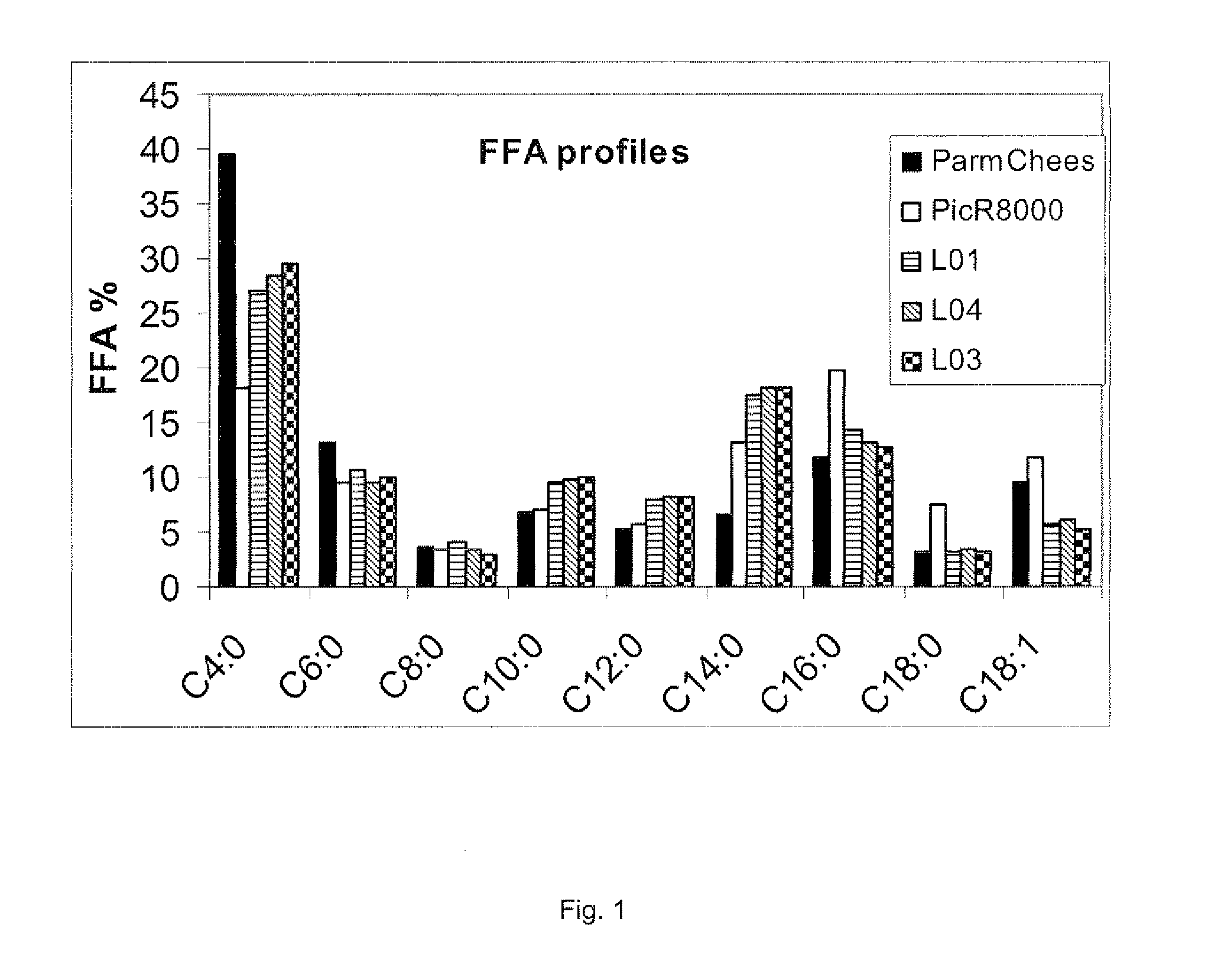Lipases with high specificity towards short chain fatty acids and uses thereof
a short-chain fatty acid, high-specificity technology, applied in the direction of dna/rna fragmentation, microbial lipases, meat/fish preservation by drying, etc., can solve the problems of poor performance of microbial lipases in this respect, poor production of enzymes, poor expression of enzymes, etc., to achieve significant improvement of lipolytic activity and expression of polynucleotide according to the invention
- Summary
- Abstract
- Description
- Claims
- Application Information
AI Technical Summary
Benefits of technology
Problems solved by technology
Method used
Image
Examples
example 1
Production of the Lipases of the Invention
[0299]The lipolytic enzymes L01, L02, L03, L04 encoded by the nucleotide sequences SEQ ID NO:1 (DNA L01), SEQ ID NO: 3 (DNA L02), SEQ ID NO: 5 (DNA L03), SEQ ID NO: 7 (DNA L04) as provided herein were obtained by constructing expression plasmids containing the DNA sequences, transforming an Aspergillus niger strain with such plasmid and growing the A. niger strains in the following way.
[0300]Fresh spores (106-107) of A. niger strains were inoculated in 20 ml CSL-medium (100 ml flask, baffle) and grown for 20-24 hours at 34° C. and 170 rpm. After inoculation of 5-10 ml CSL pre-culture in 100 ml CSM medium (500 ml flask, baffle) the strains were fermented at 34° C. and 170 rpm for 3-5 days.
[0301]Cell-free supernatants were obtained by centrifugation of the fermentation broth at 5000×g for 30 minutes at 4° C. The cell-free supernatants are stored at −20° C. until use. Optionally the supernatant can be filtered further over a GF / A Whatmann Glass...
example 2
Purification of the Lipolytic Enzyme of the Invention
[0304]After thawing of the frozen cell-free supernatants obtained in example 1 the supernatants were centrifuged extensively at 4° C. to remove any solids. In order to remove low molecular weigth contaminations the supernatants were ultrafiltrated using a Millipore Labscale TFF system equipped with a filter with a 10 kDa cut-off. The samples were washed 3-5 times with 40 ml volumes of cold 100 mM phosphate buffer pH 6.0 including 0.5 mM CaCl2. The final volume of the enzyme solution was 30 ml and is further referred to as “ultrafiltrate”.
[0305]For further purification the ultrafiltrate can be applied to a MonoQ anion exchange column. The salt gradient was set to 1M NaCL over 20 column volumes. Buffers were a mixture of 70 mM Bis-TRIS and 50 mM TRIS. The pH was set with 0.1M HCl. Surprisingly it was observed that best results were obtained when the purification was performed at pH=9, where the lipase elutes at a conductivity of 35 ...
example 3
Assays
[0311]Lipase activity was determined spectrophotometrically by using the chromogenic substrate p-nitrophenyl palmitate (pNPP, Sigma N-2752). In this assay the pNPP is dissolved in 2-propanol (40 mg pNPP per 10 ml 2-propanol (Merck 1.09634)) and suspended in 100 mM Acetate buffer pH=5.0 containing 1.0% Triton X-100 (Merck 1.12298) (5 ml substrate in 45 ml buffer). The final substrate concentration is 1.1 mM. The lipase is incubated with this substrate solution at 37° C. for 10 minutes. The reaction is stopped by addition of stop buffer 2% TRIS (Merck 1.08387)+1% Triton X-100 in a 1:1 ratio with respect to the reaction mixture and subsequently the formed p-nitrophenol (pNP) is measured at 405 nm. This assay can also be applied at different pH values in order to determine pH dependence of a lipase. It should be understood that at different pH values different buffers might be required or that different detergents might be necessary to emulsify the substrate. One lipase unit is de...
PUM
| Property | Measurement | Unit |
|---|---|---|
| temperature | aaaaa | aaaaa |
| temperature | aaaaa | aaaaa |
| particle size distribution | aaaaa | aaaaa |
Abstract
Description
Claims
Application Information
 Login to View More
Login to View More - R&D
- Intellectual Property
- Life Sciences
- Materials
- Tech Scout
- Unparalleled Data Quality
- Higher Quality Content
- 60% Fewer Hallucinations
Browse by: Latest US Patents, China's latest patents, Technical Efficacy Thesaurus, Application Domain, Technology Topic, Popular Technical Reports.
© 2025 PatSnap. All rights reserved.Legal|Privacy policy|Modern Slavery Act Transparency Statement|Sitemap|About US| Contact US: help@patsnap.com



